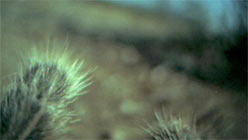A man has attached a video camera to the back of a tarantula. Each hair-covered leg jumps in front of the lens and we are at gravel-level, scurrying across the open plain. Are we running from a predator? Hunting for food? The screen goes black. When the lens opens again, we are seeing through the eyes of a cow.
These are the videos that make up The Museum of Animal Perspectives by Sam Easterson (he has also attached cameras to a falcon, a pheasant, and a tumbleweed). Created for “educational purposes,” they are also some of the most exciting video footage imaginable, and the opening work in EcoArchive: Meditations on Time and Nature at Intersection 5M Gallery. The show presents nine artists working in a variety of media who take a studious approach to the subject of nature, resulting in a show that feels both bleak in its outlook and beautiful in its honesty.
Most virulent is the repetition of empty landscapes. Just inside the door are a series of charcoal-dark photographs of lakes and deserts in the western United States by Chris McCaw. Each bears a clean burn mark through the print in the shape of an arch, crossing the sky in a diagonal like a shooting star. McCaw builds his own cameras to make these “unique gelatin silver negatives.” The exposures can be hours long, and are photographs of an extremity: land underexposed to the point of exclusion, sun so hot the paper catches fire.

“Bay Dredge,” Cynthia Hooper, 2010.
Also featured are several videos by Cynthia Hooper. Even, lonely landscapes with a dead-center horizon are cut in slices by pipes or false roads. Without affectation, Hooper uses video to document the effects of industrialization and land mismanagement. Each space is shown just long enough to take in the discolored water, the unfriendly sky, or the barren zone of past development. In the best of these, Exportadora de Sal (2007), traces of disruption include a tarp-covered hillside and a culvert pumping crystalline water from one nowhere to another. A layer of drifting foam makes even the ground feel unstable. It quakes and shivers, and is blown in gusts directly at the camera. Beyond giant beeping machinery, the only living thing trapped in the space is a man in thigh-high wading boots, testing the depth of a salt pool with a two-by-four. Hooper cautiously wraps the viewer into her stories: I found myself marveling at the oblique characteristics of the landscapes and compelled to read their full histories.



